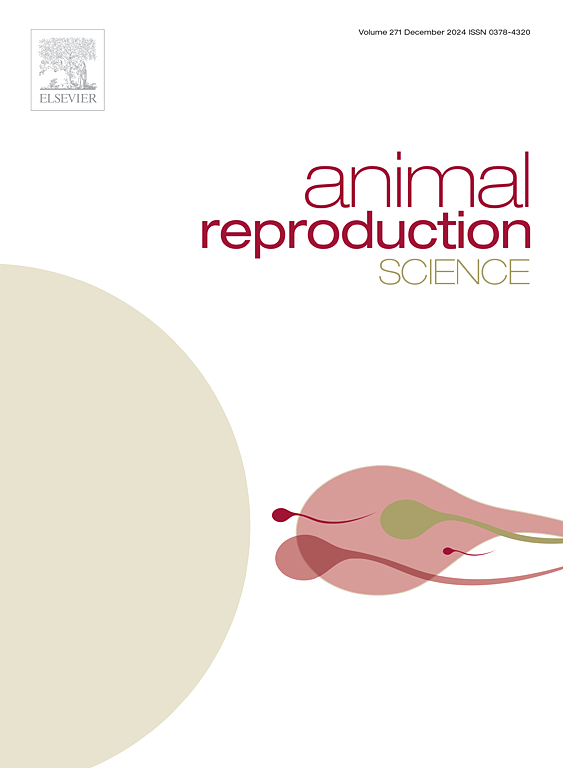Substrate stiffness modifies gene expression and transcriptional response of equine endometrial fibroblasts to TGF-β1
IF 2.2
2区 农林科学
Q1 AGRICULTURE, DAIRY & ANIMAL SCIENCE
引用次数: 0
Abstract
Equine endometrial fibrosis is a leading cause of subfertility in aging mares. Fibrosis is a reparative response involving excess deposition of extracellular matrix (ECM) and increasing tissue stiffness. Augmented rigidity itself can drive fibrosis, by stimulating transition from fibroblasts to myofibroblasts. Myofibroblasts release latent transforming growth factor beta 1 (TGF-β1) from the ECM, thereby activating this profibrotic cytokine. Tissue culture polystyrene (TCP) is commonly used for in vitro experiments. The endometrium, however, is considerably softer than TCP. This study critically evaluated the use of hydrogels versus TCP. Differences in transcript abundance between equine endometrial fibroblasts cultured on TCP and hydrogels of decreasing stiffness (25 kPa to 2 kPa) and their transcriptional response to TGF-β1, were examined. Cells cultured on substrates of varying stiffness exhibited visual variations concerning adherence, morphology, and cell density, besides differences in basal gene expression and transcriptional response to TGF-β1. On stiffer substrates, the smooth muscle genes TAGLN and ACTA2, alongside the transcripts encoding the signaling proteins PDGFB, CCN2, and SERPINE1 were expressed at higher levels. This pattern was also evident for integrin receptor subunit ITGAV, while ITGB5 was expressed at lower levels on stiffer substrates. While ITGB3 demonstrated a response to TGF-β1 exposure independent of stiffness, an increase in transcript abundance of PDGFB, ITGAV, and ITGB5 towards TGF-β1 was only observed on softer hydrogels. The results highlight the importance of stiffness in cellular regulatory patterns, particularly relevant to fibrosis research. We recommend critically reconsidering the use of TCP when designing experiments in vitro.
底物硬度改变马子宫内膜成纤维细胞对TGF-β1的基因表达和转录反应
马子宫内膜纤维化是衰老母马生育能力低下的主要原因。纤维化是一种涉及细胞外基质(ECM)过度沉积和组织刚度增加的修复反应。增强的刚性本身可以通过刺激成纤维细胞向肌成纤维细胞的转变来驱动纤维化。肌成纤维细胞从ECM释放潜伏转化生长因子β1 (TGF-β1),从而激活这种促纤维化细胞因子。组织培养聚苯乙烯(TCP)通常用于体外实验。然而,子宫内膜比TCP要软得多。本研究对水凝胶与TCP的使用进行了批判性评估。研究了TCP培养的马子宫内膜成纤维细胞与硬度降低的水凝胶(25 kPa ~ 2 kPa)之间转录物丰度的差异及其对TGF-β1的转录反应。在不同硬度的基质上培养的细胞,除了基础基因表达和对TGF-β1的转录反应存在差异外,在粘附、形态和细胞密度方面也表现出明显的差异。在较硬的底物上,平滑肌基因TAGLN和ACTA2以及编码信号蛋白PDGFB、CCN2和SERPINE1的转录本的表达水平较高。这种模式在整合素受体亚基ITGAV中也很明显,而ITGB5在较硬的底物上的表达水平较低。虽然ITGB3对TGF-β1暴露表现出独立于硬度的反应,但PDGFB、ITGAV和ITGB5对TGF-β1的转录丰度增加仅在较软的水凝胶上观察到。结果强调了细胞调节模式中硬度的重要性,特别是与纤维化研究相关。我们建议在设计体外实验时批判性地重新考虑TCP的使用。
本文章由计算机程序翻译,如有差异,请以英文原文为准。
求助全文
约1分钟内获得全文
求助全文
来源期刊

Animal Reproduction Science
农林科学-奶制品与动物科学
CiteScore
4.50
自引率
9.10%
发文量
136
审稿时长
54 days
期刊介绍:
Animal Reproduction Science publishes results from studies relating to reproduction and fertility in animals. This includes both fundamental research and applied studies, including management practices that increase our understanding of the biology and manipulation of reproduction. Manuscripts should go into depth in the mechanisms involved in the research reported, rather than a give a mere description of findings. The focus is on animals that are useful to humans including food- and fibre-producing; companion/recreational; captive; and endangered species including zoo animals, but excluding laboratory animals unless the results of the study provide new information that impacts the basic understanding of the biology or manipulation of reproduction.
The journal''s scope includes the study of reproductive physiology and endocrinology, reproductive cycles, natural and artificial control of reproduction, preservation and use of gametes and embryos, pregnancy and parturition, infertility and sterility, diagnostic and therapeutic techniques.
The Editorial Board of Animal Reproduction Science has decided not to publish papers in which there is an exclusive examination of the in vitro development of oocytes and embryos; however, there will be consideration of papers that include in vitro studies where the source of the oocytes and/or development of the embryos beyond the blastocyst stage is part of the experimental design.
 求助内容:
求助内容: 应助结果提醒方式:
应助结果提醒方式:


